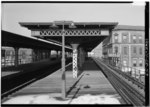48th Police Precinct Station
Bronx building and structure stubsGovernment buildings in the BronxGovernment buildings on the National Register of Historic Places in New York CityHistory of the BronxInfrastructure completed in 1901 ... and 6 more
Italian Renaissance Revival architecture in the United StatesNational Register of Historic Places in the BronxNew York City Police Department buildingsNew York City Registered Historic Place stubsPolice stations on the National Register of Historic PlacesRenaissance Revival architecture in New York City

48th Police Precinct Station is a historic police station located at 1925 Bathgate Avenue in the Tremont neighborhood of the Bronx, New York City. It was completed in 1901 and is a freestanding, three story rectangular block, seven bays wide. The facades are composed of yellow brick with stone trim in the Italian Renaissance Revival style. It was formerly used by the New York City Police Department, but ceased use as a police station in the 1970s. As of June 2010, it was occupied by Sharon Baptist Headstart. It was listed on the National Register of Historic Places in 1983.
Excerpt from the Wikipedia article 48th Police Precinct Station (License: CC BY-SA 3.0, Authors, Images).48th Police Precinct Station
Bathgate Avenue, New York The Bronx
Geographical coordinates (GPS) Address Nearby Places Show on map
Geographical coordinates (GPS)
| Latitude | Longitude |
|---|---|
| N 40.847333333333 ° | E -73.897055555556 ° |
Address
Bathgate Avenue 1925
10457 New York, The Bronx
New York, United States
Open on Google Maps








